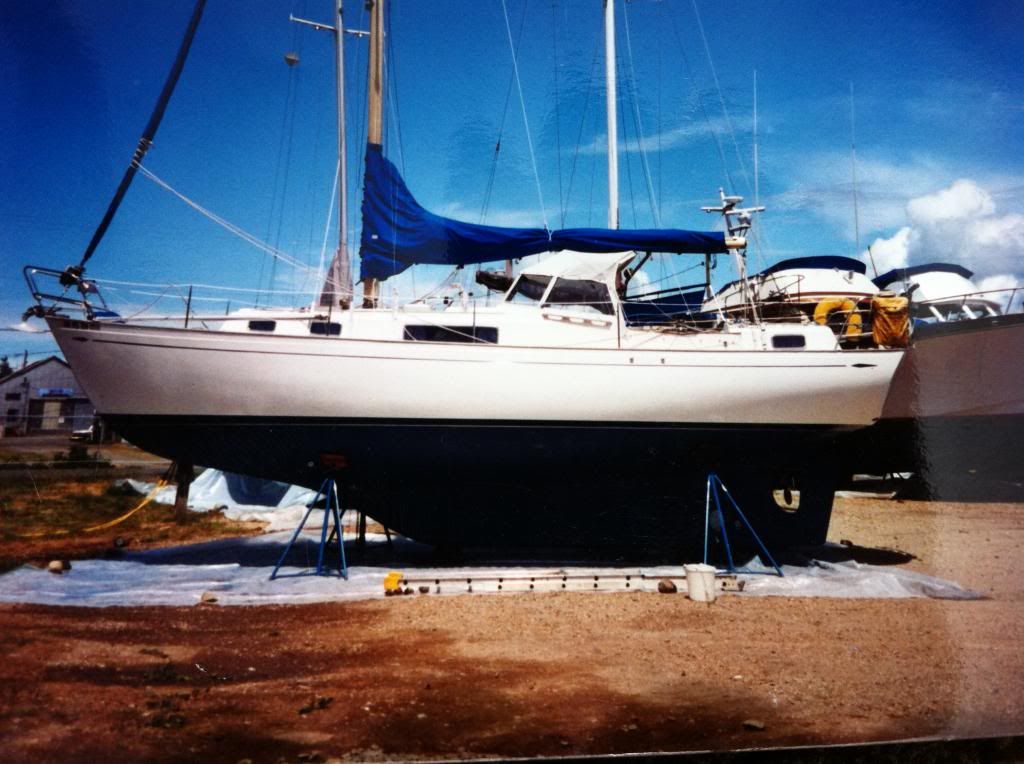 it's not only against the law to pump sewage overboard, it's just wrong. So a modern marine head pumps poop and pee into a holding tank...
it's not only against the law to pump sewage overboard, it's just wrong. So a modern marine head pumps poop and pee into a holding tank...
Sedna's holding tank was forward under the vberth with a pumpout opening on the deck.

2. The hoses in the head (bathroom) rose up 4 feet on the wall looking ugly and requiring a lot of pumping to get the sewage up over the peak so that gravity could do it's thing.

The daunting task of fixing my head was inevitable.
I just couldn't see how simply replacing my toilet was going to solve my issues. I could move the holding tank closer to the Head and shorten the hoses. I could replace gaskets and couplings. No matter what, I'd still be packing a tank full of stinky sewage. And... I'd have the big loops of hoses and holes (sea cocks) in the bottom of my boat.
I began researching other options and what I found surprised me.
There were threads on Cruisers Forum from happy converts to composting toilets. Then there were the You Tubes, Blogs, and Waterless Toilet Web Sites (Separett, Natures Head, Air Head, C-Head). Being a lifelong tree hugger, I was off and running.

Next thing I knew I was ripping out my old head and plumbing. Believe me, it was a dirty gross job.
 The worst part was removing the hoses. I tried decoupling, and finally resorted to sawing, ripping, and yanking with authority!
The worst part was removing the hoses. I tried decoupling, and finally resorted to sawing, ripping, and yanking with authority!
There was the issue of the through hull to be plugged.

I tapped in a temporary wooden plug, but I still had this thing about coming home from working out of town all week to a sunken boat. And I knew from trial that the open sea cock gushed like a fire hose. This little issue was solved by an expanding neoprene plug from the hardware store (cost $4). I did replace the standard washers, bolt, and nut that came with the plug with stainless steel to avoid galvanic corrosion.
 I needed a temporary toilet during the reconstruction and chose a simple 5 gal bucket from Home Depot with my old toilet seat atop. For now, I pee into a separate container. Eventually I will have a urine separating toilet (more about that later).
I needed a temporary toilet during the reconstruction and chose a simple 5 gal bucket from Home Depot with my old toilet seat atop. For now, I pee into a separate container. Eventually I will have a urine separating toilet (more about that later).

A trip to the garden center and a couple bucks and I had my peat moss compost base.
Amazingly, even this simple solution is contained and doesn't smell like poop.
I have a temporary lid with vent for when I'm out of town to improve air flow and keep the material in the bucket dry. I've also tried adding ashes from my wood stove, coffee grounds, and bought a coco-hull brick for composting medium. I read coffee is a natural pesticide.

I bought some black buckets because they apparently keep the bugs/flies at bay. I got some screw lids, grates, and PVC tubing. One nice thing, all this stuff is cheap and simple to work with.
Now I'm in the design and mock-up stage. My challenge is the small space available, won't hold a commercially built unit so I'm going DIY... I downloaded a 3D modeling tool called Sketchup and I'm really having fun with the whole project.
Every once in a while I'd motor over to the pump out station and empty the tank. The pump out works like a giant vacuum cleaner and with a little practice I didn't get a faceful of ick when doing it.
But I had a few issues with this arrangement.
1. The input for water to the toilet was down under the floorboards meaning I had to lift the boards and open and close the valve when coming to the boat or leaving for any length of time. No one wants to come home after a week away to find their house underwater from a ruptured hose.

3. The hose to the holding tank was so long that poo-water was trapped in the line and backflowed into the head (toilet) if one didn't close the valve every time one used the toilet.

The daunting task of fixing my head was inevitable.
I just couldn't see how simply replacing my toilet was going to solve my issues. I could move the holding tank closer to the Head and shorten the hoses. I could replace gaskets and couplings. No matter what, I'd still be packing a tank full of stinky sewage. And... I'd have the big loops of hoses and holes (sea cocks) in the bottom of my boat.
I began researching other options and what I found surprised me.
There were threads on Cruisers Forum from happy converts to composting toilets. Then there were the You Tubes, Blogs, and Waterless Toilet Web Sites (Separett, Natures Head, Air Head, C-Head). Being a lifelong tree hugger, I was off and running.

Next thing I knew I was ripping out my old head and plumbing. Believe me, it was a dirty gross job.
 The worst part was removing the hoses. I tried decoupling, and finally resorted to sawing, ripping, and yanking with authority!
The worst part was removing the hoses. I tried decoupling, and finally resorted to sawing, ripping, and yanking with authority!There was the issue of the through hull to be plugged.

I tapped in a temporary wooden plug, but I still had this thing about coming home from working out of town all week to a sunken boat. And I knew from trial that the open sea cock gushed like a fire hose. This little issue was solved by an expanding neoprene plug from the hardware store (cost $4). I did replace the standard washers, bolt, and nut that came with the plug with stainless steel to avoid galvanic corrosion.
 I needed a temporary toilet during the reconstruction and chose a simple 5 gal bucket from Home Depot with my old toilet seat atop. For now, I pee into a separate container. Eventually I will have a urine separating toilet (more about that later).
I needed a temporary toilet during the reconstruction and chose a simple 5 gal bucket from Home Depot with my old toilet seat atop. For now, I pee into a separate container. Eventually I will have a urine separating toilet (more about that later). 
A trip to the garden center and a couple bucks and I had my peat moss compost base.
Amazingly, even this simple solution is contained and doesn't smell like poop.
I have a temporary lid with vent for when I'm out of town to improve air flow and keep the material in the bucket dry. I've also tried adding ashes from my wood stove, coffee grounds, and bought a coco-hull brick for composting medium. I read coffee is a natural pesticide.

I bought some black buckets because they apparently keep the bugs/flies at bay. I got some screw lids, grates, and PVC tubing. One nice thing, all this stuff is cheap and simple to work with.
Now I'm in the design and mock-up stage. My challenge is the small space available, won't hold a commercially built unit so I'm going DIY... I downloaded a 3D modeling tool called Sketchup and I'm really having fun with the whole project.

































